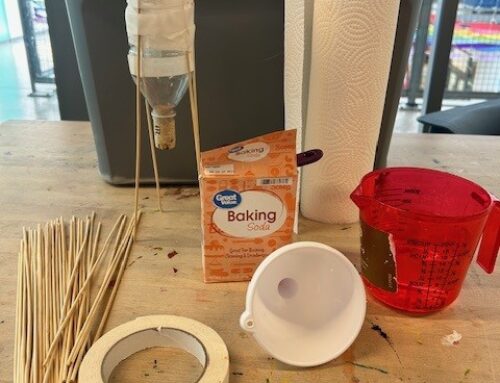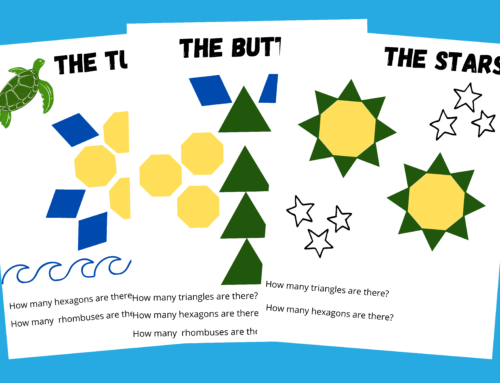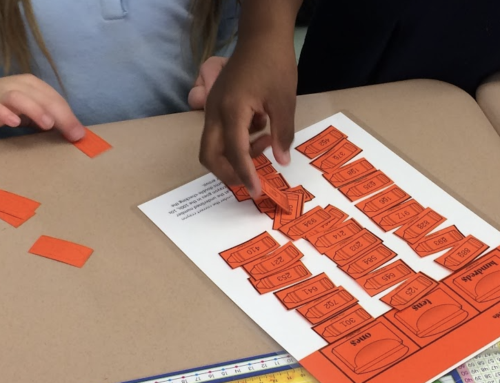It’s in your classroom, it’s at home, and it’s probably lodged between your car seats. Slime is just about the hottest trend in kitchen chemistry and new versions of homemade slime are being created all the time. From glitter slime to magnetic slime, we’ve just about thought of everything.
While slime is a great lesson on polymers, it’s not the only chemistry lesson worth exploring. To celebrate National Chemistry Week this week, let’s explore some other chemistry activities that you can easily implement in your STEM classroom.
Lather Print Nametags
You can make awesome nametags using nothing but shaving cream, an index card, and food coloring. Dish out a small amount of shaving cream for each student. Have them flatten out the shaving cream using a popsicle stick so the surface is flat and about the size of an index card. Next, have the students place a few (3-4) drops of food coloring onto the surface of the shaving cream.
Using a toothpick, students can swirl the food coloring around the surface of the shaving cream. When they’re ready, they can place their index card onto the surface of the shaving cream. When they remove the card, they will wipe off the excess shaving cream and reveal their beautiful creation! Once the card is dry, have the students write their name on it.

The food coloring is transferred to the paper, but the shaving cream is not. That is because the paper is made of polar molecules and so is the food coloring. They are attracted to one another, but the shaving cream (whose molecules have a non-polar tail) is not, meaning it can be wiped away. This is an example of a hydrophilic (water loving) interaction in chemistry!
Penny Battery
Did you know you can make your own battery? All you need is a few pennies, galvanized zinc washers, paper, and vinegar. Cut circles out of a paper towel that are roughly the same diameter as the penny. You will begin to build your battery by placing a penny on a table. Then place a paper towel circle onto the penny. Drop a couple drops of vinegar onto the paper and then stack a zinc washer onto the paper (optional – add salt to your vinegar). Repeat this process until you have created a few stacks. Connect the stack to an LED and watch it light up!

You have created a battery through an electrochemical reaction. The vinegar acts as an electrolyte connecting the two dissimilar metals (electrodes) and causing a chemical reaction. When you connect an LED to these electrodes, electrons flow creating an electric current!
Rainbow Roses
Have you ever gone to the florist and seen these colorful, rainbow bouquets? Despite what your students might think, these brilliant shades don’t grow in the wild and rely on simple chemistry to become so vivid.
Take a white flower, like a rose or a carnation, and slice the tip of its stem into three sections. Dip each section into a mixture of food flooring and water. As the stem brings water up to the petals with capillary action, it will transport the colored water up the stem, and you’ll see a color change in the petals over the course of a couple of days. You can also do this experiment with celery if roses are out of budget.

Soap Boat Races
Nothing is more exciting than watching a group of students race paper boats across a tub of water. First, have your students cut little boats out of paper. It’s also helpful to cut a small notch out of the back of the boat. Then fill a tray with water (like a single-use aluminum baking tray) and have the students place their boats gently on top of the water. The students can dip the toothpick into dish soap and then poke the soapy stick into the water behind the boat (or in the boat’s notch). They’ll be amazed as the boat propels forward!

The boat stays afloat on the water due to surface tension. When the students place the soap onto the water, it breaks the forces of surface tension causing the boat to move. This is also known as the Marangoni effect, because there is a gradient of surface tension at a boundary between two phases. Helpful tip – you could also use isopropyl alcohol instead of soap if it’s available so that you can reuse the water more times before changing it out.
Isn’t chemistry the coolest?! Happy National Chemistry Week from STEM Supplies!
Check out some of our favorite Chemistry products, including the Happy Atoms!








Leave A Comment